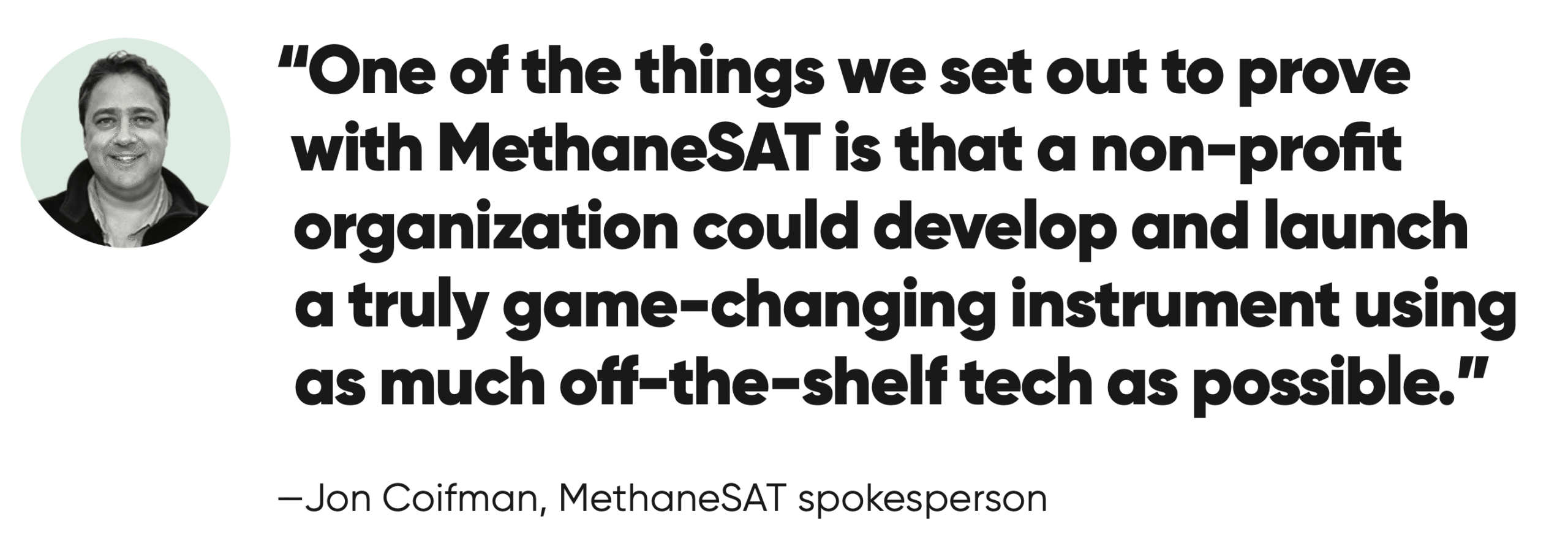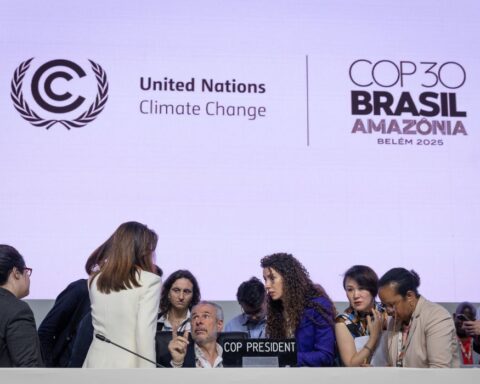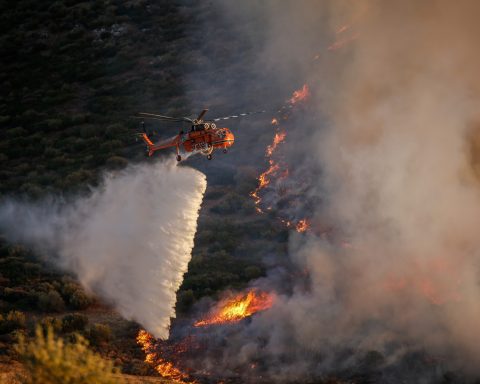For those most invested in the struggle to evade the worst effects of global warming, MethaneSAT carried high hopes. Built and operated by a subsidiary of the large U.S. non-profit Environmental Defense Fund (EDF), the satellite was created to provide a comprehensive global record of methane emissions and show the oil and gas industry how to stop leaking so much of this highly potent greenhouse gas into the atmosphere.
Though not quite a silver bullet in the fight against methane emissions, MethaneSAT was something more like an effective and well-placed spy. But just over a year into its five-year mission, the satellite stopped working.
On June 20, the boxy, solar-powered device passed over the North Pole and made a link with the High Arctic ground station in the Norwegian archipelago of Svalbard. The communication was normal and there were no signs of trouble. But less than an hour later, after travelling half the circumference of the world at 27,000 kilometres per hour, it had gone silent as it hurtled over the South Pole.
EDF has not made contact with the methane-tracking satellite since it mysteriously stopped communicating that day. Subsequent photos taken from space show that the satellite is intact and its trajectory has not changed. EDF has commissioned an anomaly review board to figure out what happened, but the results have not been published.
A new height of ambition
For many, MethaneSAT was a preeminent symbol of human ingenuity in the face of the overwhelming challenge of shifting our entire energy system away from fossil fuels. The project has been lionized in the media and awarded generous philanthropic funding to cover the US$88-million cost to build and launch it into space, including from the Bezos Earth Fund.
Methane, which is responsible for about 30% of global warming, traps around 80 times more heat than carbon dioxide over a 20-year period. But it also has a much shorter lifespan in the atmosphere, so lowering its emissions is considered a low-hanging fruit for effective climate action – especially because natural gas consists almost entirely of methane, so the industry is theoretically incentivized to avoid bleeding it off into the atmosphere from leaky operations.
“Despite the scale of the problem, solving it is largely cost-effective,” Dominic Watson, a senior manager on the energy transition team at EDF, has said. Plugging leaks also isn’t overly complicated: “It’s plumbing, it’s not rocket science.”
MethaneSAT’s wasn’t the only satellite tracking methane emissions from space, but it was the only one built specifically for this task, and it could measure methane “over large areas but with enough precision to identify specific facilities and oil wells,” The New York Times has reported. The satellite’s high-precision spectrometer could detect tiny differences in the concentration of methane molecules – as little as two to three parts per billion – from 580 kilometres in the sky.

But providing a critical new vantage on worldwide methane emissions wasn’t the only thing that made MethaneSAT special. It also demonstrated that complex and expensive ventures to combat climate change could be realized outside the framework of government or private industry. The satellite represented, both figuratively and literally, a new height of ambition for environmental non-profits.
Coming in the midst of a dramatic reversal on climate policy by the U.S. administration, MethaneSAT’s untimely ending was a most unwelcome development for the climate movement. The announcement that the satellite had gone dark was met with an online outpouring of sadness and disappointment.
But in New Zealand, which contributed NZ$32 million to the overall project, the response among some scientists has been different. They aren’t sad. They’re mad about it.
A troubled relationship
“We were played like a fiddle by these guys,” says Richard Easther, an astrophysicist who was consulted by the New Zealand government about the project, speaking via video call from his office at the University of Auckland, where he teaches in the physics department.
Easther views his government’s sizable investment in MethaneSAT as “a once-in-a-generation opportunity to have a huge technical leap in a globally significant area.” New Zealand joined the project in an effort to boost its aerospace sector. Instead, the country “settled for what was always going to be a participation trophy at best,” he argues.
The satellite stopped working just days before students and faculty at the Te Pūnaha Ātea Space Institute at the University of Auckland were scheduled to assume control of the mission, following several months of delays. The failure to transition control to the university at the original deadline in March prompted mounting public frustration and calls for transparency.
Easther is leading the criticism and has called for a no-blame review to understand “how New Zealand blew past so many red flags about MethaneSAT’s operation.” He alleges that the mission operators “kept pumping out upbeat comms even after it became apparent that the spacecraft had major problems.”
Methane trackers pick up the slack as U.S. regulatory pressure evaporates
Easther’s ire is directed mainly at his own government, for spending so much money on a space project without soliciting bids for other projects. “It’s not the result of a competitive call for proposals or a pre-existing need,” he says.
New Zealand does contribute to the world’s methane problem, but its emissions come from livestock – those famous cow and sheep burps – not oil and gas. “If we wanted to understand agricultural methane . . . there’s dozens of other things we could have done and they may have been more effective,” Easther claims.
‘Typical teething issues’
The story behind New Zealand’s involvement with MethaneSAT begins with Peter Beck, who holds the title of “the world’s newest space billionaire.” He is the founder and CEO of Rocket Lab, the upstart competitor to SpaceX whose shares have gone interstellar in the past year.
Rocket Lab puts satellites into space and has made New Zealand the third-most-frequent country to launch rockets to orbit after the United States and China – a feat that Beck achieved without the benefit of a university degree. New Zealanders are proud of him the way Americans used to be proud of Elon Musk. So when Beck said he wanted to get involved with MethaneSAT, people paid attention.
Rocket Lab’s stunning success in launching satellites was a prime factor that brought the Environmental Defense Fund into partnership with the New Zealand government in 2018. In the end, MethaneSAT grew too big for Rocket Lab, which specializes in smaller launches, and SpaceX won the contract. “If we’d known right from the beginning that Rocket Lab wouldn’t launch it, I am sure the conversation would not have happened,” Easther says.
MethaneSAT’s utility for tracking agricultural methane emissions was also misrepresented, according to reporting by Eloise Gibson, a climate change correspondent for New Zealand’s public broadcaster RNZ. When EDF approached the New Zealand Space Agency at the Ministry of Business, Innovation and Employment about the idea for the partnership, staff saw it as an opportunity to position New Zealand as a serious player in both space science and climate change, she reported.
Gibson obtained communications by space agency staff at the time. They wrote that “the satellite will be able to detect emissions from agriculture” and “importantly . . . should be able to provide data that would enable more precise measurement of methane emissions in New Zealand and help inform policy related to agricultural emissions.”
They were wrong. New Zealand scientists told the space agency the mission was “hopelessly oversold” for livestock gas tracking and “would not add much to New Zealand’s understanding of its greenhouse gas profile from farming,” Gibson reported. The agency ultimately realized the error, but the rationale persisted in underpinning the nation’s involvement in the project.
Jon Coifman, a spokesperson for MethaneSAT, wrote in an email that the purpose of New Zealand’s research investment was to “gain deeper insight and understanding into the usefulness of high precision methane measurements in understanding agricultural methane emissions” – that is, to study the satellite’s applicability for this task.

Once the satellite was in space, it suffered ongoing technical issues that delayed its scheduled handover to the control station at the University of Auckland. One of its three thrusters repeatedly malfunctioned, and increased solar activity caused it to go into “safe mode” multiple times. Rather than being handed off to New Zealand scientists, control was transferred back to its manufacturer, Blue Canyon Technologies in Colorado.
Craig Rodger, a professor of physics at New Zealand’s University of Otago, has questioned whether solar activity should have been so disruptive: “There have been moments when it’s been interesting in the last year and a bit, but there have not been extreme conditions in the space environment,” he wrote in published comments. “We’re talking about normal, slightly active conditions . . . Typically, people build their equipment to handle that.”
Coifman describes these difficulties as “typical teething issues.” Solar activity has not been attributed as a reason for MethaneSAT’s cessation on June 20.
A report by the New Zealand space agency published on November 7 found that the satellite’s technical failure “occurred in components outside of New Zealand’s control and within the bounds of accepted risk in space missions.” MethaneSAT’s sensor “performed exceptionally well and delivered meaningful science data which New Zealand researchers are using,” the report states.
A different model for satellite development
Easther and others have questioned whether MethaneSAT made the best decisions in the satellite’s development. In a post on LinkedIn, Leigh Foster, former director of space systems at Rocket Lab, accused the project of having failed “to select the right spacecraft manufacturer, and a failure to focus on the right level of technical rigor pre-launch and during [optical alignment, integration and testing].”
Responding to these criticisms, Coifman wrote that the project sought to prove that a non-profit could build and launch a “game-changing instrument using as much off-the-shelf tech as possible,” rather than relying on slow-moving government-run space missions or commercial providers that keep the data private. “MethaneSAT is about transparency,” he wrote. “The data is meant to be open source . . . because we believe that’s the fastest way to turn data into action to protect the climate. The urgency of that purpose means we couldn’t afford the time or money involved in those other approaches.”
Methane emissions are vastly underreported, but they could be slashed quickly
If it had been a conventional NASA-type mission, MethaneSAT would have had “back-ups for the back-ups,” Coifman wrote. But adding those layers of redundancy “would have made it much slower and much more expensive – and totally beyond our reach.”
Even so, MethaneSAT was fully tested before launch according to best practices and protocols, Coifman says.
“The teams at MethaneSAT and Environmental Defense Fund worked with some of the most seasoned professionals in the commercial and government aerospace sectors. We had no reason to doubt their judgement,” Andrew Johnson, deputy head of the New Zealand Space Agency, wrote in a statement to Corporate Knights.
Not a failure
In a blog post earlier this month, Easther excoriated EDF for failing to disclose any results from its investigation into what went wrong with the satellite, writing, “Whatever was learnt has not been shared, a situation that comes as no surprise to those of us who watched this saga play out.”
He’s not alone in seeking clarity. “Even though it appears that New Zealand was not likely involved in the chain of events leading to the underperformance of MethaneSat, we as investors in the project are entitled to an explanation,” Nicholas Rattenbury, another physicist at the University of Auckland, has written in a collection of expert reactions on MethaneSAT’s breakdown for New Zealand’s Science Media Centre.
For its part, EDF rejects the idea that its MethaneSAT project was a failure. “We didn’t accomplish all the things we wanted to, but we’re proud of what we did accomplish,” says Steven Hamburg, EDF’s chief scientist and the project lead for MethaneSAT. The project exceeded expectations in terms of data quality, he says. “We really did push ahead a long way from where others were.”
The high-precision data that MethaneSAT collected in its one year of operation showed what many suspected: that emissions from oil and gas operations are higher than previously estimated or that the industry reports.
The data is also starting to serve its purpose in steering the fossil fuel industry toward methane emission reductions, at least by validating successful regulations. In September, New Mexico Governor Michelle Lujan Grisham revealed that her state’s methane intensity – a measure of escaped gas – is only 1.2% compared to Texas’s 3.1%, despite much steeper increases in production, and that the captured methane was worth US$125 million in additional natural gas production and $27 million in tax and royalty revenue. The difference is attributed to New Mexico’s stronger methane rules enacted in 2021.
Jon Goldstein, associate vice president for energy transition at EDF, said in a statement that the data obtained by the satellite proves “that cutting methane pollution and waste delivers economic benefits while protecting air quality and our climate.”
Mark Mann is the managing editor at Corporate Knights.
The Weekly Roundup
Get all our stories in one place, every Wednesday at noon EST.







